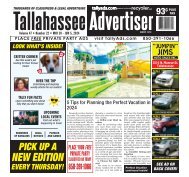070122_TT_AllPages
You also want an ePaper? Increase the reach of your titles
YUMPU automatically turns print PDFs into web optimized ePapers that Google loves.
THETRUCKER.COM<br />
EQUIPMENT & TECH<br />
JULY 2022 • 17<br />
Manufacturing dilemma<br />
INDUSTRY ANALYSTS SAY MORE THAN 21,000 NEW TRUCKS SOLD IN MAY WHILE ORDERS DECLINED<br />
CLIFF ABBO<strong>TT</strong> | CONTRIBUTING WRITER<br />
May sales of new Class 8 trucks on the<br />
U.S. market increased by 7.6% in May over<br />
April sales figures, according to data received<br />
from ACT Research. Sales of 21,272<br />
units made May the best month of the year<br />
so far — and the best May since 2019. May<br />
was also the first month when sales exceeded<br />
those in the corresponding month in<br />
2021, when 18,761 trucks were sold.<br />
So, how did OEMs sell more than 21,000<br />
trucks in a month when just 19,500 were<br />
built?<br />
“We’ve been seeing inventory building<br />
and you wonder, with demand so strong,<br />
why is inventory continuing to grow?” said<br />
Kenny Vieth, president and senior analyst at<br />
ACT Research.<br />
Part of the answer is that many trucks<br />
were nearly completed in previous months<br />
and then parked at the factory or the dealer,<br />
waiting for a final part or two to come in before<br />
delivery to the customer.<br />
“It shows maybe some parts finally made<br />
it to the supply chain,” Vieth added.<br />
Of the new Class 8 trucks sold, 16,402<br />
(77.1%) were fifth-wheel equipped over-theroad<br />
tractors, while the remainder were vocational<br />
models with dump, concrete, trash<br />
or other bodies mounted.<br />
Freightliner led the charge, reporting<br />
sales of 7,309, according to data received<br />
from Wards Intelligence. Compared to<br />
April’s 6,653, Freightliner sales increased<br />
6.9%.<br />
The biggest growth of sales by percentage,<br />
however, went to International, which<br />
reported sales of 2,799 — an increase of<br />
46.5% over April’s 1,911.<br />
Kenworth’s 2,803 units sold topped<br />
April’s 2,588 by 8.3% but lagged behind May<br />
2021 sales of 2,919 by 4%. PACCAR sibling<br />
Peterbilt reported sales of 3,375 trucks in<br />
May, a 6.4% climb from 3,173 sold in April<br />
and 15.1% better than the 2,933 sold in May<br />
2021.<br />
Volvo reported sales of 2,546, topping<br />
April sales by 121 trucks for an increase of<br />
5%. Compared with May 2021, when 1,413<br />
Volvos were sold, sales increased by a whopping<br />
80.2%. Volvo-owned Mack Truck reported<br />
sales of 1,372, a decline of 5.2% from<br />
April’s 1,448 trucks sold.<br />
Western Star, a Freightliner company,<br />
sold 511 units in May, down 23.7% from<br />
April’s 670. Still, sales bested the 447 sold in<br />
May 2021 by 14.3%.<br />
Truck manufacturers have been hampered<br />
for more than a year by supply chain<br />
issues. Semiconductors are in short supply,<br />
and components needed to build trucks<br />
have been delayed by COVID closings. Materials<br />
such as steel and aluminum have<br />
been hard to come by and expensive when<br />
available.<br />
To counter supply chain issues, OEMs are<br />
taking some unusual steps. Some are building<br />
trucks that are parked on the lot, waiting<br />
for a final component to arrive. Once<br />
the parts are available, they can quickly be<br />
installed and the trucks moved out.<br />
Another tactic is to simply sell trucks<br />
without some of the options. Trucks have<br />
been delivered to carriers without window<br />
actuators, ADAS features such as adaptive<br />
cruise control, and even without passenger<br />
seats.<br />
Orders for new trucks have far outstripped<br />
production, resulting in wait times<br />
of a year or longer for delivery.<br />
FTR reported that new truck orders are<br />
dropping to levels far below last year’s pace,<br />
but part of the reason is that OEMs are reluctant<br />
to book orders so far in the future.<br />
“The supply chain was making slight<br />
improvements in the last few months,” said<br />
Don Ake, vice president, commercial vehicles<br />
for FTR. “The OEMs are not confident<br />
they can increase production in the second<br />
half of the year; therefore, they are not able<br />
to take more orders.”<br />
In the used truck market, prices have<br />
reached record levels. One reason is that<br />
some carriers turned to used trucks when<br />
they couldn’t get new trucks to expand<br />
their fleets. Another reason, judging from<br />
the record numbers of new carrier registrations<br />
granted by the DOT last year, is drivers<br />
buying trucks and starting their own companies<br />
to take advantage of surging spot<br />
freight rates.<br />
The pendulum has swung the other way<br />
in the trucking industry as rising fuel costs<br />
and falling rates have made it more difficult<br />
for small trucking businesses to profit. Large<br />
numbers of them are closing their doors.<br />
Avery Vise, vice president of trucking at<br />
FTR, addressed the issue in a June 6 podcast.<br />
“Net revocations of for-hire authority<br />
approached 9,300 (in May) and were more<br />
than double the number recorded in April<br />
and were a record,” he said, pointing out<br />
that most revocations are made due to insurance<br />
lapses, which have a 30-day grace<br />
period.<br />
“Most of the operations that had authority<br />
revoked in May probably already failed<br />
in March and in April. I’m sure that most<br />
of them probably stopped operating in that<br />
first two weeks after the surge in diesel prices,”<br />
Vise concluded.<br />
A June 15 press release from ACT Research<br />
was entitled, “US Used Truck Sales<br />
Cycle at the Beginning of the End.” The release<br />
predicted that used truck prices have<br />
reached a peak and will soon begin coming<br />
down.<br />
Unfortunately, rising fuel costs, falling<br />
iStock Photo<br />
According to industry analysts, May sales of new Class 8 trucks on the U.S. market increased by 7.6% in May over<br />
April sales figures. Sales of 21,272 units made May the best month of the year so far — and the best May since<br />
2019. May was also the first month when sales exceeded those in the corresponding month in 2021, when 18,761<br />
trucks were sold.<br />
freight rates and rising interest rates seem<br />
to conspire against a truck purchase. On<br />
June 15, the Federal Reserve raised its key<br />
interest rate by .75%, the largest increase<br />
since 1994. Fed chair Jay Powell said that<br />
a similar hike is possible at the Fed’s next<br />
meeting in July.<br />
“By raising interest rates, the Fed is<br />
hitting the economy’s brakes to slow the<br />
economy down. So, that’s, going to add to<br />
the problem of declining freight,” explained<br />
Vieth.<br />
Recession is very possible, Vieth said. At<br />
least, a freight recession. As consumers spend<br />
more of their dollars on fuel and food, less is<br />
left over to purchase goods that truckers haul<br />
as freight.<br />
“Because the freight cycle has been<br />
growing for two years, and, is due for a rollover,”<br />
Vieth continued. “The roll off is occurring<br />
almost exactly when we thought it<br />
was going to. What’s different is the speed<br />
at which the roll off is occurring is much<br />
sharper than our forecasts were originally<br />
anticipating.”<br />
Nobody knows how long the trucking<br />
downcycle will last, or how deep it will go, but<br />
for now, investing in new equipment remains<br />
an expensive proposition with little guarantee<br />
of profits in a tightening market. 8

















